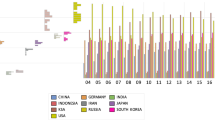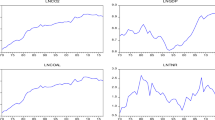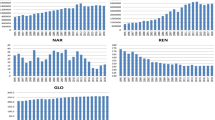Abstract
The present study investigates the causality between energy consumption, natural resources, and carbon emissions volatility. For empirical results, the study analyzed panel data of a Group of Twenty (G-20) countries from 1995 to 2018. The results of Pooled Mean Group (PMG) showed that the consumption of conventional energy sources increases the carbon emissions in the region under consideration. The results also showed that economic growth and carbon emissions are associated with each other according to the Environmental Kuznets Curve hypothesis. The findings showed that rent on mineral resources, oil resources, and forest rent have a positive and significant impact on carbon emissions in G-20 countries. The findings of this study show the complex nature of the relationship between natural resources consumption and carbon dioxide emissions. The study suggests a three-dimensional policy framework for the group of twenty countries of economic cooperation to address the environmental issues with a special focus on natural resources preservation and green economic growth.
Similar content being viewed by others
Data availability
Not applicable.
References
Acheampong AO (2018) Economic growth, CO2 emissions and energy consumption: what causes what and where? Energy Econ 74:677–692
Adams S, Nsiah C (2019) Reducing carbon dioxide emissions; does renewable energy matter? Sci Total Environ 693:133288
Aşici AA (2013) Economic growth and its impact on environment: a panel data analysis. Ecol Ind 24:324–333
Bekun FV, Emir F, Sarkodie SA (2019) Another look at the relationship between energy consumption, carbon dioxide emissions, and economic growth in South Africa. Sci Total Environ 655:759–765
Bokpin GA, Mensah L, Asamoah ME (2015) Foreign direct investment and natural resources in Africa. J Econ Stud
Breitung J (2005) A parametric approach to the estimation of cointegration vectors in panel data. Economet Rev 24(2):151–173
Cansino JM, Román-Collado R, Molina JC (2019) Quality of institutions, technological progress, and pollution havens in Latin America. An analysis of the environmental Kuznets curve hypothesis. Sustainability 11(13):3708
Churchill SA, Inekwe J, Smyth R, Zhang X (2019) R&D intensity and carbon emissions in the G7: 1870–2014. Energy Econ 80:30–37
Costantini V, Martini C (2010) A modified environmental Kuznets curve for sustainable development assessment using panel data. Int J Global Environ Issues 10(1–2):84–122
Cui H, Zhao T, Shi H (2018) STIRPAT-based driving factor decomposition analysis of agricultural carbon emissions in Hebei, China. Pol J Environ Stud 27(4)
Downey L, Bonds E, Clark K (2010) Natural resource extraction, armed violence, and environmental degradation. Organ Environ 23(4):417–445
Farhani S, Mrizak S, Chaibi A, Rault C (2014) The environmental Kuznets curve and sustainability: a panel data analysis. Energy Policy 71:189–198
Hanif I (2017) Economics-energy-environment nexus in Latin America and the Caribbean. Energy 141:170–178
Hanif I (2018a) Energy consumption habits and human health nexus in Sub-Saharan Africa. Environ Sci Pollut Res 25(22):21701–21712
Hanif I (2018b) Impact of economic growth, nonrenewable and renewable energy consumption, and urbanization on carbon emissions in Sub-Saharan Africa. Environ Sci Pollut Res 25(15):15057–15067
Hanif I (2018c) Impact of fossil fuels energy consumption, energy policies, and urban sprawl on carbon emissions in East Asia and the Pacific: a panel investigation. Energ Strat Rev 21:16–24
Hanif I, Gago-de-Santos P (2017) The importance of population control and macroeconomic stability to reducing environmental degradation: an empirical test of the environmental Kuznets curve for developing countries. Environ Dev 23:1–9
Hanif I, Chaudhry IS (2015) Interlinks of fiscal decentralization and public investment in Pakistan. Pak J Commer Soc Sci (PJCSS) 9(3):850–864
Hanif I, Aziz B, Chaudhry IS (2019a) Carbon emissions across the spectrum of renewable and nonrenewable energy use in developing economies of Asia. Renew Energy 143:586–595
Hanif I, Raza SMF, Gago-de-Santos P, Abbas Q (2019b) Fossil fuels, foreign direct investment, and economic growth have triggered CO2 emissions in emerging Asian economies: some empirical evidence. Energy 171:493–501
Hanif I, Wallace S, Gago-de-Santos P (2020) Economic growth by means of fiscal decentralization: an empirical study for federal developing countries. SAGE Open 10(4):2158244020968088
Huang Y, Raza SMF, Hanif I, Alharthi M, Abbas Q, Zain-ul-Abidin S (2020) The role of forest resources, mineral resources, and oil extraction in economic progress of developing Asian economies. Resour Policy 69:101878
Alharthi M, Hanif I (2020) Impact of blue economy factors on economic growth in the SAARC countries. Marit Bus Rev 5(3):253–269
Im KS, Pesaran MH, Shin Y (2003) Testing for unit roots in heterogeneous panels. J Econom 115(1):53–74
Jorgenson AK (2003) Consumption and environmental degradation: a cross-national analysis of the ecological footprint. Soc Probl 50(3):374–394
Lee KH, Min B (2015) Green R&D for eco-innovation and its impact on carbon emissions and firm performance. J Clean Prod 108:534–542
Levin A, Lin CF, Chu CSJ (2002) Unit root tests in panel data: asymptotic and finite-sample properties. J Econom 108(1):1–24
Li T, Wang Y, Zhao D (2016) Environmental Kuznets curve in China: new evidence from dynamic panel analysis. Energy Policy 91:138–147
Liu D, Xiao B (2018) Can China achieve its carbon emission peaking? A scenario analysis based on STIRPAT and system dynamics model. Ecol Ind 93:647–657
Luo G, Weng JH, Zhang Q, Hao Y (2017) A reexamination of the existence of environmental Kuznets curve for CO 2 emissions: evidence from G20 countries. Nat Hazards 85(2):1023–1042
Marsiglio S, Ansuategi A, Gallastegui MC (2016) The environmental Kuznets curve and the structural change hypothesis. Environ Resource Econ 63(2):265–288
Mensah CN, Long X, Dauda L, Boamah KB, Salman M (2019) Innovation and CO 2 emissions: the complementary role of eco-patent and trademark in the OECD economies. Environ Sci Pollut Res 26(22):22878–22891
Zambrano-Monserrate MA, Silva-Zambrano CA, Davalos-Penafiel JL, Zambrano-Monserrate A, Ruano MA (2018) Testing environmental Kuznets curve hypothesis in Peru: the role of renewable electricity, petroleum and dry natural gas. Renew Sustain Energy Rev 82:4170–4178
Munasinghe M (1999) Is environmental degradation an inevitable consequence of economic growth: tunneling through the environmental Kuznets curve. Ecol Econ 29(1):89–109
Nathaniel SP, Iheonu CO (2019) Carbon dioxide abatement in Africa: the role of renewable and non-renewable energy consumption. Sci Total Environ 679:337–345
Nadkarni MV (2010) Poverty, environment, development: a many-patterned nexus. Econ Polit Wkly 1184–1190
Nazir MI, Nazir MR, Hashmi SH, Ali Z (2018) Environmental Kuznets curve hypothesis for Pakistan: empirical evidence from ARDL bound testing and causality approach. Int J Green Energy 15(14–15):947–957
Ongan S, Isik C, Ozdemir D (2020) Economic growth and environmental degradation: evidence from the US case environmental Kuznets curve hypothesis with application of decomposition. J Environ Econ Policy 1–8
Perman R, Ma Y, McGilvray J, Common M (2003). Natural resource and environmental economics. Pearson Education
Pesaran MH, Yamagata T (2008) Testing slope homogeneity in large panels. J Econom 142(1):50–93
Pesaran MH, Shin Y, Smith RP (1999) Pooled group estimation of dynamic heterogeneous panels. J.Am. Stat Assoc 94:621–634
Scherr SJ (2000) A downward spiral? Research evidence on the relationship between poverty and natural resource degradation. Food Policy 25(4):479–498
Shi X, Liu H, Riti JS (2019) The role of energy mix and financial development in greenhouse gas (GHG) emissions reduction: evidence from ten leading CO 2 emitting countries. Econ Politica 36(3):695–729
Sinha A, Shahbaz M (2018) Estimation of environmental Kuznets curve for CO2 emission: role of renewable energy generation in India. Renew Energy 119:703–711
Westerlund J (2008) Panel cointegration tests of the Fisher effect. J Appl Economet 23(2):193–233
World Bank (2020) World development indicators 2016. World Bank Publications, cop, Washington, DC, p 2020
Yang Z, Abbas Q, Hanif I, Alharthi M, Taghizadeh-Hesary F, Aziz B, Mohsin M (2020) Short-and long-run influence of energy utilization and economic growth on carbon discharge in emerging SREB economies. Renew Energy 165:43–51
Zakarya GY, Mostefa B, Abbes SM, Seghir GM (2015) Factors affecting CO2 emissions in the BRICS countries: a panel data analysis. Procedia Econ Financ 26:114–125
Funding
Supported by Humanities Special Foundation Southwest Petroleum University (Grant Number: 2019RW010).
Author information
Authors and Affiliations
Contributions
Chen Yu-Ke: Initial draft preparation; Rehmat Ullah Awan: Review of literature, data collection, and tabulation; Babar Aziz: Methodological framework and technical advice. Ishtiaq Ahmad: Econometric results estimation, hypothesis testing; Sarah Waseem (corresponding author email: sarah.wasimfccu@gmail.edu.pk): Results interpretation and diagnostic testing.
Corresponding author
Ethics declarations
Ethics approval
This is an original work that has not been submitted anywhere else for publication.
Consent to participate
All authors have contributed to the submitted paper.
Consent for publication
The paper submitted with the mutual consent of authors for publication in Environmental Science and Pollution Research.
Competing interests
Not applicable.
Additional information
Responsible Editor: Roula Inglesi-Lotz
Publisher's note
Springer Nature remains neutral with regard to jurisdictional claims in published maps and institutional affiliations.
Rights and permissions
About this article
Cite this article
Yu-Ke, C., Awan, R.U., Aziz, B. et al. The relationship between energy consumption, natural resources, and carbon dioxide emission volatility: empirics from G-20 economies. Environ Sci Pollut Res 29, 25408–25416 (2022). https://doi.org/10.1007/s11356-021-17251-6
Received:
Accepted:
Published:
Issue Date:
DOI: https://doi.org/10.1007/s11356-021-17251-6




